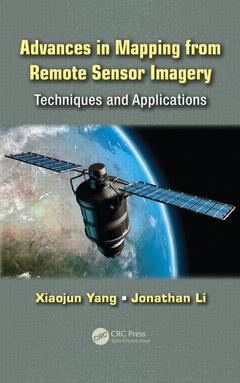Description
Advances in Mapping from Remote Sensor Imagery
Techniques and Applications
Coordinators: Yang Xiaojun, Li Jonathan
Language: English
Subject for Advances in Mapping from Remote Sensor Imagery:
Keywords
LiDAR Data; Data Set; Remote Sensing; Hyperspectral Data; Geographic Feature Mapping; SAR Image; Environmental Mapping; Airborne LiDAR; Ecological Mapping; Urban Heat Island; SAR Acquisition; DEM Generation; LiDAR Data Set; DEM Error; SMA; HSI Data; LiDAR System; LiDAR Point; Linear Deformation Rate; Aster GDEM; Meris Image; Interferometric Synthetic Aperture Radar; Forest LAI; SAR; LiDAR Measurement; DEM Production; PS Point; Nighttime Lights Imagery
Publication date: 12-2012
Support: Print on demand
Publication date: 10-2017
· 15.6x23.4 cm · Paperback
Description
/li>Contents
/li>Readership
/li>Biography
/li>
Advances in Mapping from Remote Sensor Imagery: Techniques and Applications reviews some of the latest developments in remote sensing and information extraction techniques applicable to topographic and thematic mapping. Providing an interdisciplinary perspective, leading experts from around the world have contributed chapters examining state-of-the-art techniques as well as widely used methods.
The book covers a broad range of topics including photogrammetric mapping and LiDAR remote sensing for generating high quality topographic products, global digital elevation models, current methods for shoreline mapping, and the identification and classification of residential buildings. Contributors also showcase cutting-edge developments for environmental and ecological mapping, including assessment of urbanization patterns, mapping vegetation cover, monitoring invasive species, and mapping marine oil spills?crucial for monitoring this significant environmental hazard.
The authors exemplify the information presented in this text with case studies from around the world. Examples include:
- Envisat/ERS-2 images used to generate digital elevation models over northern Alaska
- In situ radiometric observations and MERIS images employed to retrieve chlorophyll a concentration in inland waters in Australia
- ERS-1/2 SAR images utilized to map spatiotemporal deformation in the southwestern United States
Aerospace sensors and related information extraction techniques that support various mapping applications have recently garnered more attention due to the advances in remote sensing theories and technologies. This book brings together top researchers in the field, providing a state-of-the-art review of some of the latest advancements in remote sensing and mapping technologies.
Modern photogrammetric mapping. Airborne LiDAR remote sensing and its applications. Advanced algorithms for land use and cover classification. Global digital elevation model development from satellite remote-sensing data. Digital elevation model generation from satellite interferometric synthetic aperture radar. Shoreline mapping. Seeing residential buildings from remotely sensed imagery: An object-oriented approach. Assessment of urbanization patterns and trends in the Gulf of Mexico region of the southeast United States with Landsat and nighttime lights imagery. Fractional vegetation cover mapping from the HJ-1 small satellite hyperspectral data. Estimating and mapping forest leaf area index using satellite imagery. Effects of the spatial pattern of vegetation cover on urban warming in a desert city. Remote sensing of algal blooms in inland waters using the matrix inversion method and semiempirical algorithms. Advanced geospatial techniques for mapping and monitoring invasive species. Surface deformation mapping with persistent scatterer radar interferometry. Mapping marine oil spills from space. Remote-sensing techniques for natural disaster impact assessment.
Xiaojun Yang is a tenured faculty member with the Department of Geography at Florida State University, USA. His research focuses on the development of geospatial science and technology to support geographic inquiries in urban and environmental domains. Dr. Yang has performed research for NASA and received grants from the NSF and EPA. He has authored or coauthored more than 80 English publications, including five books with John Wiley, Springer, and CRC/Taylor & Francis.
Dr. Yang has served as a guest editor for several peer-reviewed journals including Photogrammetric Engineering and Remote Sensing, ISPRS Journal of Photogrammetry and Remote Sensing, International Journal of Remote Sensing, Computers, Environment and Urban Systems, and Environmental Management. He currently serves the second term as chair of the International Cartographic Association (ICA) Commission on Mapping from Remote Sensor Imagery (2011–2015) and director of the Cartography and Geographic Information Society (2012–2015).
Jonathan Liis professor of geomatics at the University of Waterloo in Canada. His research interests include remote sensing, mobile mapping, and geographic information systems. Dr. Li has authored more than 190 publications, including five books with Springer and Taylor & Francis. He is vice chair of the International Cartographic Association (ICA) Commission on Mapping from Remote Sensor Imagery (2011-2015), chair of the ISPRS Inter-Commission Working Group V/I on Land-Based Mobile Mapping Systems (2008-2012), and vice chair of the International Federation of Surveyors (FIG) Commission 4 on Hydrography (2011-2014).




